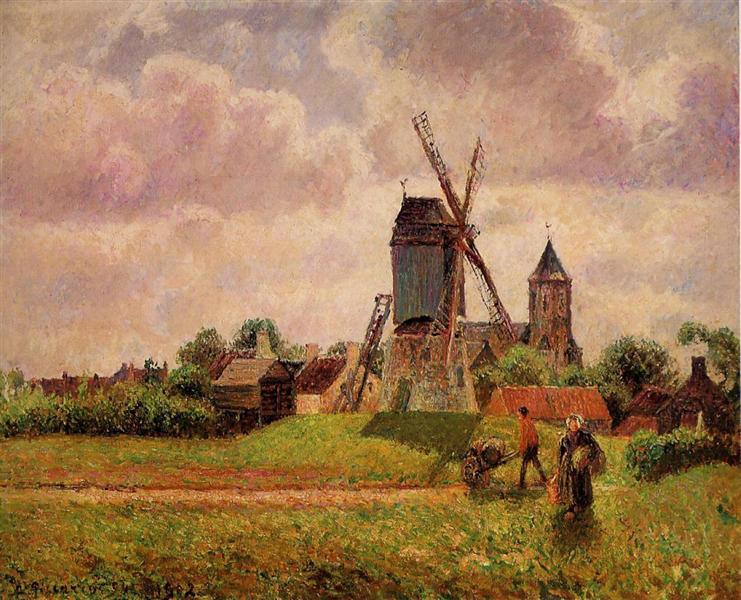Beschrijving
The painting "The Windmill at Knocke - Belgium - 1902" by Camille Pissarro is a work that, like many of his creations, encapsulates the essence of Impressionism and the artist's fascination with light and landscape. A pioneer of the Impressionist movement, Pissarro adopted a unique approach to the depiction of the environment throughout his career, combining meticulous observation of nature with a technical execution that highlights the vibrant interplay between color and light.
When looking at “The Windmill at Knocke,” the viewer is immediately drawn to the central structure of the windmill, which rises majestically on the horizon, symbolizing both the rusticity of the Belgian countryside and the power of nature in a changing rural environment. The composition is characterized by a balanced arrangement, where the windmill serves as a visual axis from which the surrounding landscape unfolds. Surrounded by green fields stretching into the distance, the windmill both imposes itself and blends into the environment. Each brushstroke is evidence of Pissarro’s distinctive technique, using a variety of hues to create an atmosphere of calm and vitality.
The use of color palette is remarkable. Pissarro employs vibrant greens and yellow hues, which invoke the brightness of a sunny day. The sky, painted in soft blues and grays, suggests a light shadow, which in turn is contrasted by the brightness of the vegetation. This chromatic interplay not only brings depth and texture to the work, but also evokes the immediacy of the moment, one of the quintessences of Impressionism. The technique of loose brushstrokes and the application of colors in vibrant fields captures the movement and fresh air of the surroundings, inviting the viewer to almost feel the breeze and ambiance of the scene.
As for the presence of human figures, the work is remarkably calm and quiet. There are no visible characters, suggesting a moment of solitude and reflection. This absence of figures can lead the viewer into a more introspective contemplation, inviting them to experience the serenity of the landscape without distractions. This is also characteristic of Pissarro's style, who often preferred the representation of his natural surroundings over the inclusion of narrative elements. In this sense, the windmill becomes almost a symbol of the connection between man and nature, a reminder of the rural life frequently found in his work.
Pissarro has been known for his inclusive approach and interest in different styles and techniques throughout his career. The Windmill at Knocke is a testament to his maturity as an artist and his ability to capture the essence of a specific place while offering a universal visual experience. Perspectives of modernity were just beginning to take shape in Europe, and in this context, Pissarro, with his deep respect for nature, offers us a vision of rural life that is both timeless and deeply contemporary.
Through this work, Camille Pissarro not only presents us with a windmill, but also invites us to explore the interactions between humans and their environment, a dialogue that remains relevant in today's world. His technique, use of color, and deliberate choice of a serene landscape devoid of human figures create a work that promises to continue to inspire and provoke reflection for future generations. Without a doubt, "The Windmill at Knocke" stands as a masterful example of Impressionism and Pissarro's ability to capture the ephemeral beauty of his world.
KUADROS ©, a famous painting on your wall.
Hand-made oil painting reproductions, with the quality of professional artists and the distinctive seal of KUADROS ©.
Painting reproduction service with satisfaction guarantee. If you are not completely satisfied with the replica of your painting, we will refund 100% of your money.

